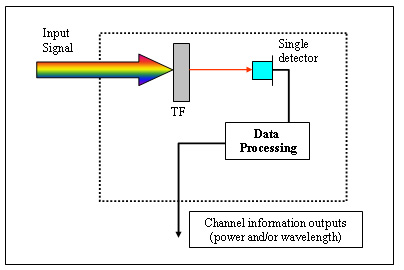Fiber Optic Tech
Applications of TOF in DWDM Systems
Tunable Optical Filters (TOFs) are indispensable key devices in Dense Wavelength Division Multiplexing (DWDM) systems. They enable functions such as wavelength selection, demultiplexing, routing, switching, dynamic al, and optical performance monitoring. With the continuous development of optical communication technology, the performance of TOFs will continue to improve, and their applications will become more extensive. The following lists application examples in various fields of DWDM:
TOF Applied to ROADM
ROADM is a flexible node device used in optical networks that can remotely configure and change the wavelength routing of optical signals without interrupting existing services. ROADM allows network operators to dynamically add, remove, or reconfigure optical wavelength channels as needed, enabling flexible network management and optimization. As a core device in DWDM systems, ROADM plays a crucial role in the transmission capacity, network topology, and key characteristics of all-optical networks.
Currently, ROADM can be classified into two types based on the method of channel add/drop: TOF-based and optical switch-based. Different TOF implementations are the primary solutions for achieving ROADM technology, facilitating network upgrades and providing operators with greater business flexibility while reducing operational costs.
Wavelength Selection and Demultiplexing
In ROADM nodes, different wavelength channels need to be separated from the optical fiber to enable adding, dropping, or rerouting. TOF can precisely the required wavelength channels, separating them from the mixed signal to achieve demultiplexing. By adjusting the filtering wavelength of TOF, different channels can be flexibly selected, enabling dynamic network configuration and reconstruction.
Wavelength Add and Drop
In ROADM nodes, new wavelength channels need to be added to the optical fiber, or existing wavelength channels need to be removed. TOF can function as a wavelength selection switch, inserting the required wavelength channels into the optical fiber or separating the unwanted wavelength channels from it. By working in conjunction with other optical devices, such as optical switches and wavelength converters, TOF can enable complex wavelength add and drop functionalities.
Wavelength Routing and Switching
In optical networks, optical signals need to be routed from one node to another based on service requirements. ROADM can dynamically change the optical signal path according to control signals. TOF can function as a wavelength selection switch, enabling flexible switching of optical signals across different paths. By working in conjunction with other optical devices, TOF can achieve complex wavelength routing and switching functionalities.
Typically, integrated multi-channel ROADM based on AOTF employs multiple AOTFs in series, working in conjunction with precise temperature control devices. Its response speed reaches the millisecond level and can cover the entire C-band for filtering. Additionally, by using TFF technology in combination with wavelength-selective switches (WSS) and wavelength blockers (WB), arbitrary wavelength add/drop for optical channels can be achieved, enabling flexible selection of optical signals.
TOF Applied to OPM
Traditional OPMs (Optical Performance Monitors) can typically only measure optical power levels but cannot assess other parameters such as wavelength and loss. By applying TOF technology to OPM, its functionality can be expanded to simultaneously measure both optical power and the transmission time of optical signals, enabling a more comprehensive uation of optical fiber link performance.
With the development of DWDM, ensuring the effective operation of optical networks under high capacity, high speed, and complex topologies has become a key research focus in the industry. As a monitoring device in DWDM systems, OPM is primarily used in three areas: DWDM system construction, DWDM system fault detection, and DWDM system degradation and aging analysis. Since its commercialization, OPM has been widely adopted by system equipment vendors, and major component manufacturers continue to innovate and enhance their OPM products.
Optical Fiber Link Fault Detection: By monitoring the transmission time and power variations of optical signals, TOF-OPM can quickly detect faults in optical fiber links (such as breaks or bends) and issue timely alerts.
Optical Fiber Link Performance Monitoring: TOF-OPM can continuously monitor the performance of optical fiber links (such as loss and dispersion), providing valuable data for network optimization and maintenance.
Optical Network Construction and Maintenance: During optical network deployment and maintenance, TOF-OPM can be used to assess the quality of optical fiber links, ensuring stable network operation.
The interferometric OPM consists of three main components: TOF, a detector, and a signal processing controller. Figure 1 illustrates the principle of an OPM based on thin-film filtering technology. The basic working principle is as follows: first, a portion of the optical power is extracted from the optical network signal. The TOF filters the incoming optical signal and transmits a specific bandwidth of the optical signal to the photodetector. The photodetector samples the optical signal and converts its amplitude into an electrical signal, which is then sent to the signal processing controller. Upon receiving the sampled data, the signal processing controller sends commands to adjust the passband wavelength of the tunable optical filter. This process is repeated until the entire required wavelength range has been scanned. Finally, the signal processor analyzes and processes the sampled data, calculating key parameters such as the optical signal's central wavelength, optical power, and OSNR. The results and spectral data are then output.

Applying TOF technology to OPM can expand its functionality, enabling it to simultaneously measure optical power and the transmission time of optical signals, thereby providing a more comprehensive uation of optical fiber link performance. TOF-OPM has broad application prospects in optical fiber link fault detection, performance monitoring, and optical network construction and maintenance.
TOF Applied to Tunable Lasers
A Tunable Optical Filter (TOF) is an optical device capable of dynamically adjusting the center wavelength and bandwidth. It plays a crucial role in tunable lasers. By selecting and transmitting or blocking specific wavelengths of light, TOF enables dynamic wavelength adjustment, meeting the diverse needs of optical communication, optical sensing, and spectral analysis.
Tunable lasers are important light sources in high-speed optical communication systems, WDM network systems, optical testing systems, and fast wavelength switching systems. Common tuning methods used internationally include adjusting the angle of the tuning cavity, acousto-optic filters, and electrically tuned liquid crystal standards. Tunable ring-cavity fiber lasers based on dielectric film filtering technology have a tuning range that covers the entire C-band, with a side-mode suppression ratio greater than 60 dB and wavelength stability better than 0.01 nm, making them promising for applications in DWDM all-optical systems.
DWDM systems are currently the most common optical-layer networking technology. Their maturity has shifted optical networks from bandwidth planning to bandwidth management. As a core optical device in DWDM systems, TOF plays a crucial role in optical signal multiplexing/demultiplexing, performance monitoring, and other areas. This also necessitates the development of TOF in the direction of narrow bandwidth, wide tuning range, and high isolation. In future optical communication systems, improving various filtering technologies and enhancing the performance parameters of TOF will remain a key focus for device manufacturers.



















